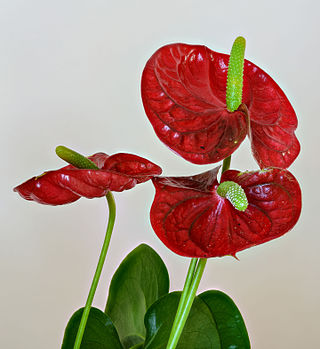
Anthurium is a genus of about 1,000 species of flowering plants, the largest genus of the arum family, Araceae. General common names include anthurium, tailflower, flamingo flower, and laceleaf.
Anthurium rigidifolium is a species of plant in the family Araceae. It is endemic to Ecuador. Its natural habitat is subtropical or tropical moist montane forests. It is threatened by habitat loss.
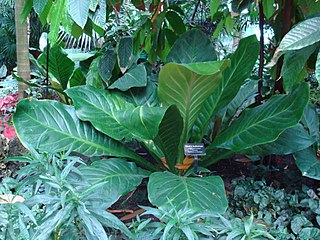
Anthurium hookeri, commonly called a bird's nest anthurium, is a species of flowering plant in the genus Anthurium. Anthurium hookeri possesses some unique features which include, short internodes, dense roots, and lanceolate cataphylls. The leaves have triangular to D-shaped petioles 2–9 cm long, are rosulate, 10–26 cm wide, 35–89 cm long. The leaves exhibit a scalariforme venation and supervolute vernation. Covering the leaves are tiny black glandular punctuates. The berries produced by the plant are white.

Flamingo lily is a common name for several species of Anthurium with large red spathes.

The National Botanic Garden of Bangladesh and the Bangladesh National Herbarium make up the largest plant conservation center in Bangladesh, with an area of around 84 hectares. It is located at Mirpur-2 in Dhaka - 1100, beside the Dhaka Zoo. It was established in 1961. It is a botanic garden, a knowledge center for nature lovers and botanists and a tourist destination. The herbarium has a scientific collection of approximately 100,000 preserved specimens of plants.

Anthurium andraeanum is a flowering plant species in the family Araceae that is native to Colombia and Ecuador. It is a winner of the Royal Horticultural Society's Award of Garden Merit.

The Living Rainforest is an indoor greenhouse tropical rainforest located in Hampstead Norreys in Berkshire, England. It is an ecological centre, educational centre and visitor attraction consisting of three glasshouses, operated and run by the Trust for Sustainable Living. The glasshouses are named Amazonica, Lowlands and Small Islands respectively.
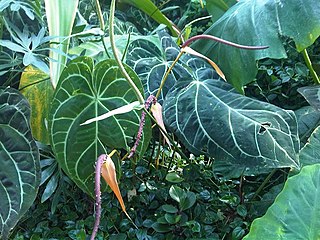
Anthurium crystallinum is a species of flowering plant in the family Araceae, native to rainforest margins in Central and South America, from Panamá to Perú. Growing to around 90 cm (35 in) tall and broad, A. crystallinum is an epiphytic perennial, characterised by large, velvety, ovate to heart-shaped leaves with prominent white veining; their blooms are somewhat visually insignificant inflorescences, with green spathes and pale green spadices, appearing throughout the year.

Anthurium clarinervium is a species of flowering plant is in the family Araceae native to Chiapas, Mexico. The Anthurium genus is known to contain approximately 1,000 species, resulting in one of the most diverse Central American tropical plant genera.

Anthurium warocqueanum, commonly known as the Queen Anthurium, is a species of plant in the genus Anthurium. Native to Colombia, it is grown in more temperate climates as a greenhouse specimen or houseplant for its ornamental foliage.
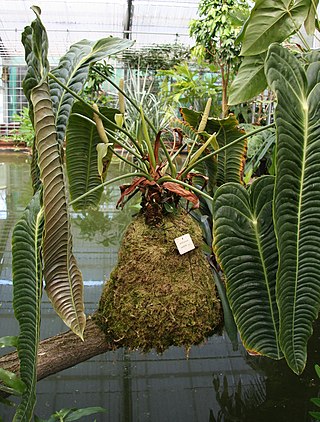
Anthurium veitchii, the king anthurium, is an epiphytic species of flowering plant in the genus Anthurium native to Colombia. It is grown in more temperate climates as a greenhouse or houseplant for its large, pendulous leaves that can be several feet long.

Anthurium pedatoradiatum or Anthurium Fingers is a species of plant in the genus Anthurium native to southern Mexico. A. pedatoradiatum has leaves with deep finger-like sections, and is terrestrial. Its natural habitat is from sea level up to 1,000 meters (3,300 ft) in the Mexican states of Veracruz, Tabasco, and Chiapas. It is related to other Anthurium in the section Schizoplacium such as Anthurium podophyllum, and its species name in Latin refers to the radiating growth of its palm-like leaves.

Anthurium scherzerianum, the flamingo flower or pigtail plant, is a species of Anthurium native to Costa Rica. It has gained the Royal Horticultural Society's Award of Garden Merit as an ornamental houseplant, kept at 15 °C (60 °F) or higher. It is naturally an epiphyte, growing on trees in the rainforest.

Anthurium magnificum is a plant in the genus Anthurium native to Colombia. Closely resembling other Anthurium species like Anthurium crystallinum, it has large, cordate leaves with prominent veining and is primarily terrestrial. Plants of the true species can be distinguished primarily by their quadrangular petioles.

Anthurium cubense is a species of flowering plant in the family Araceae, native to southeastern Mexico, Central America, Cuba, Colombia, and Venezuela. A large species, it is occasionally kept as a hothouse specimen or as a house plant. With Anthurium pendulifolium, it is a parent of the 'Big Bill' hybrid cultivar, with leaves exceeding 10 ft (3 m).
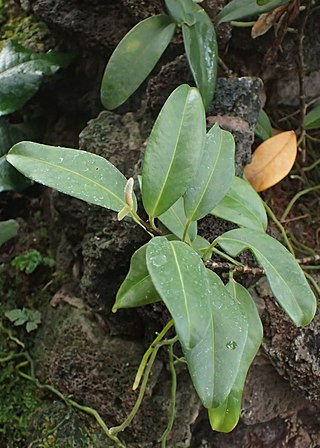
Anthurium scandens is a species of plant in the genus Anthurium. Native from Mexico to Southeast Brazil, it is the most widely distributed species of Anthurium in the Americas, and also extends to the Caribbean including Haiti, Puerto Rico, Jamaica, and other nations.

Anthurium podophyllum is a species of plant in the genus Anthurium native to coastal areas of the Mexican states of Veracruz and Oaxaca. A terrestrial species, it grows in tropical forest understories in seasonally dry areas. It is named for its palmate leaves that somewhat resemble plants in the (unrelated) genus Podophyllum, and which have many subdivisions. It is related to other terrestrial Anthurium with similar leaf morphology in the section Schizoplacium, such as Anthurium pedoradiatum, and produces orange berries.

Anthurium bonplandii is a species of plant in the genus Anthurium native to South America. A member of the Anthurium sect. Pachyneurium, it grows terrestrially or occasionally epiphytic or epilithic. It is often confused with Anthurium jenmanii when young and Anthurium atropurpureum.

Anthurium argyrostachyum is a species of plant in the genus Anthurium native to Ecuador and Colombia. Growing as a small shrub or an epiphyte, it is best recognized by its foliage that has triangular or arrowhead-like shape, a long central lobe, and parallel veins. It is a member of the section Polyneurium, and is thus related to Anthurium corrugatum, Anthurium panduriforme, and others that share its parallel venation and other characteristics.

















